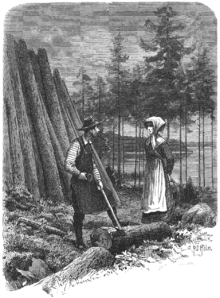Hulder
This articleneeds additional citations forverification.(November 2022) |
 "Huldra's Nymphs" (1909) byBernard Evans Ward | |
| Grouping | Legendary creature |
|---|---|
| Sub grouping | Humanoid |
| Similar entities | Siren,succubus,mermaid |
| Country | Scandinavia |
| Region | Europe |
Ahulder(orhuldra) is a seductive forest creature found inScandinavian folklore.Her name derives from a root meaning "covered" or "secret".[1]InNorwegian folklore,she is known ashuldra( "the [archetypal] hulder", though folklore presupposes that there is an entire Hulder race and not just a single individual). She is known as theskogsrå"forest spirit" orTallemaja"pine tree Mary" inSwedish folklore,anduldainSámifolklore. Her name suggests that she is originally the same being as thevölvadivine figureHuldand the GermanHolda.[2]
The word hulder is only used of a female; a "male hulder" is called ahuldrekalland also appears in Norwegian folklore. This being is closely related to other underground dwellers, usually calledtusser(sg.,tusse).
Though described as beautiful, the huldra is noted for having a distinctive inhuman feature—an animal's tail (usually a cow's or a fox's) and/or a back resembling a hollowed-out tree.
Folklore
[edit]The hulder is one of severalrå(keeper, warden), including the aquaticsjöråorhavsfru,later identified with amermaid,and thebergsråin caves and mines who made life tough for the poor miners.
More information can be found in the collected Norwegian folktales ofPeter Christen AsbjørnsenandJørgen Moe.
Relations with humans
[edit]
The hulders were held to be kind to charcoal burners, watching their charcoal kilns while they rested. Knowing that she would wake them if there were any problems, they were able to sleep, and in exchange they left provisions for her in a special place. A tale fromNärkeillustrates further how kind a hulder could be, especially if treated with respect (Hellström 1985:15).
Toponyms
[edit]A multitude of places in Scandinavia are named after the Hulders, often places by legend associated with the presence of the "hidden folk". Here are some examples showing the wide distribution of Hulder-related toponyms between the northern and southern reaches of Scandinavia, and the terms usage in different language groups' toponyms.
Danish
[edit]- Huldremose(Hulder Bog) is a bog onDjursland,Denmark famous for the discovery of theHuldremose Woman,a bog body from 55BC.
Norwegian
[edit]- Hulderheimis southeast on the island ofKarlsøyainTromscounty, Norway. The name means "Home of the Hulder".
- Hulderhusanis an area on the southwest part of Norway's largest island,Hinnøya,whose name means "Houses of the Hulders".
Sámi
[edit]- Ulddaidvárriis a place inKvænangen MunicipalityinTromscounty (Norway). The name means "Mountain of the Hulders" inNorth Sámi.
- Ulddašvággiis a valley southwest ofAltainFinnmarkcounty (Norway). The name means "Hulder Valley" in North Sámi. The peak guarding the pass over from the valley to the mountains above has a similar name, Ruollačohkka, meaning "Troll Mountain" —and the large mountain presiding over the valley on its northern side is called Háldi, which is a term similar to the above-mentioned Norwegian rå, that is a spirit or local deity which rules a specific area.
In Popular Culture
[edit]In the mobile gameYear Walk,one of the Watchers is a Huldra.
They are mentioned in Seanan MacGuire's October Daye series in the book "A red-rose chain".
Neil Gaiman's novellaThe Monarch of the Glen,published in the collectionFragile Things,includes references to Hulder legends.
In the subsequentYear Walk: Bedtime Stories for Awful Children,the first chapter is devoted to the Huldra.[3]
In chapter 40 (chapter XL: "A day in Hälsingland", section: "The Animals' New Year's Eve" ) of the novel "Nils Holgersson's Wonderful Journey through Sweden", a narrated legend mentions the Huldra.
In the video game "Bramble: The Mountain King," developed by Dimfrost Studios in 2023, the boss Skogsrå is a Huldra.
See also
[edit]- Banshee
- Baobhan sith
- Bloody Mary (folklore)
- Clíodhna
- Dames blanches
- Enchanted Moura
- Glaistig
- Glashtyn
- Huldufólk
- Leanan sídhe
- Mami Wata
- Mavka
- Miss Koi Koi
- Neck (water spirit)
- Nymph
- Patasola
- Pontianak (folklore)
- Rusalka
- Samodiva (mythology)
- Sihuanaba
- Siren (mythology)
- Skogsrå
- Succubus
- Thale(film)
- Weiße Frauen
- White Lady (ghost)
- Wight
- Witte Wieven
References
[edit]- ^Hellström, AnneMarie.Jag vill så gärna berätta(in Norwegian).ISBN9179080022.
- ^"Nordisk familjebok".runeberg.org(in Swedish). 1 January 1909.
- ^"Year Walk Bedtime Stories for Awful Children".Simogo.2 September 2015.Retrieved17 June2022.

